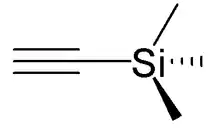Trimethylsilylacetylene
Trimethylsilylacetylene is the acetylene HC2Si(CH3)3. It is a colorless liquid. Called "tms acetylene", it is used as a source of "HC2−". The trimethylsilyl group protected can be desilyated with TBAF. Using this protected alkyne, as opposed to acetylene itself, prevents further coupling reactions and also has the benefit of being a liquid.[1] A less expensive alternative reagent is 2-methylbut-3-yn-2-ol, which after alkynylation is deprotected with base.
 | |
| Names | |
|---|---|
| IUPAC name
ethynyltrimethylsilane | |
| Identifiers | |
3D model (JSmol) |
|
| ChemSpider | |
| ECHA InfoCard | 100.012.655 |
PubChem CID |
|
CompTox Dashboard (EPA) |
|
| |
| |
| Properties | |
| C5H10Si | |
| Molar mass | 98.220 g·mol−1 |
| Appearance | colorless liquid |
| Density | 0.69 g/mL |
| Boiling point | 53 °C (127 °F; 326 K) |
| Hazards | |
| Safety data sheet | External MSDS |
EU classification (DSD) (outdated) |
|
| R-phrases (outdated) | R11 |
| S-phrases (outdated) | S16 S24/25 S29 S33 S9 |
Except where otherwise noted, data are given for materials in their standard state (at 25 °C [77 °F], 100 kPa). | |
| Infobox references | |
Trimethylsilylacetylene is commercially available. It may also be prepared in a manner similar to other silyl compounds: deprotonation of acetylene with a Grignard reagent, followed by reaction with trimethylsilyl chloride.[2]
References
- Godson C. Nwokogu, Saskia Zemolka, Florian Dehme (2007). "Trimethylsilylacetylene". EROS. doi:10.1002/047084289X.rt288.pub2. ISBN 978-0471936237.CS1 maint: uses authors parameter (link)
- Andrew B. Holmes and Chris N. Sporikou (1993). "Trimethylsilylacetylene". Organic Syntheses.; Collective Volume, 8, p. 606
This article is issued from Wikipedia. The text is licensed under Creative Commons - Attribution - Sharealike. Additional terms may apply for the media files.